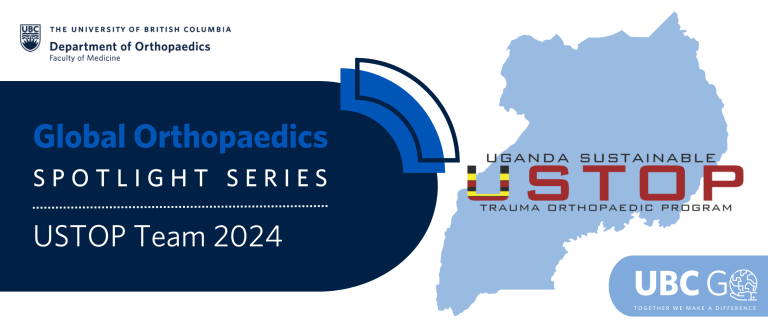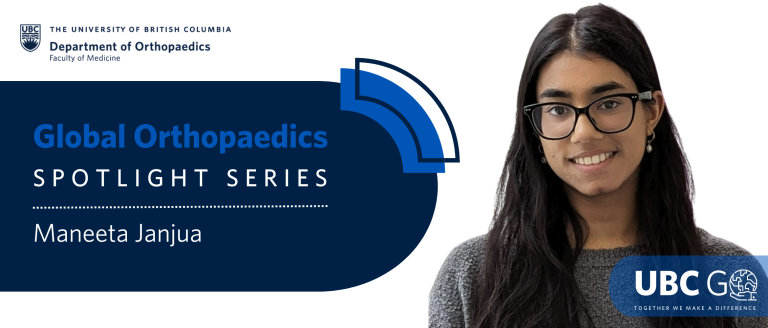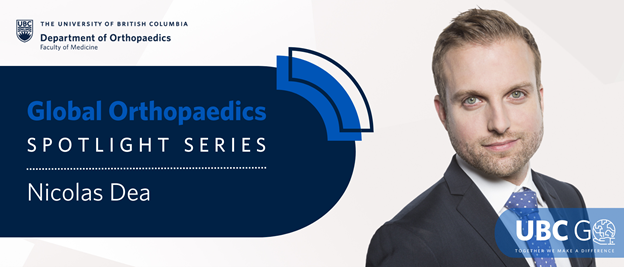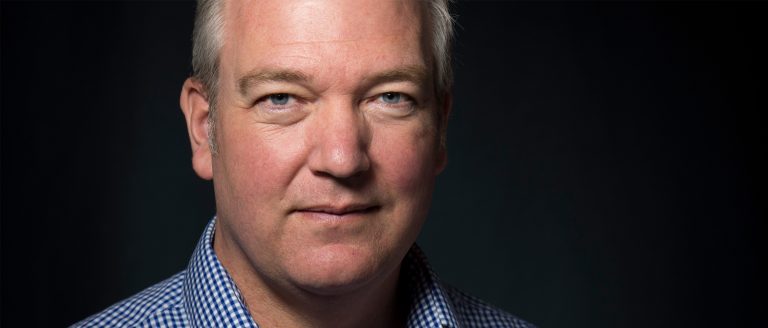Our UBC Global Orthopaedics (UBC GO) Spotlight series features in-depth conversations with a UBC Department of Orthopaedics member about their involvement in global orthopaedic initiatives.
This spotlight introduces us to Dr. Nathan O’Hara, who serves as a Clinical Research Manager at the University of Maryland, School of Medicine. Dr. O’Hara gained significant experience in international development during his tenure with the department of orthopaedics at UBC from 2007 to 2015. Let’s delve into his journey.
Dr. O’Hara’s journey into global health and orthopedics commenced after graduating from the UBC Sauder School of Business, where his interest shifted towards charitable endeavors rather than conventional business roles. Inspired by a trip to Kenya, he initiated a scholarship program for female students, marking his initial involvement in global work. This paved the way for his participation in various projects with UBC Orthopaedics for almost 8 years, with a primary focus on the Uganda Sustainable Trauma Orthopaedics Program (USTOP), eventually extending collaborations to McMaster University and other institutions. Overcoming barriers such as limited resources and fostering lasting relationships were central to his efforts, aimed at empowering local communities and institutions towards sustainability. Currently working as a research faculty at the University of Maryland, Dr. O’Hara remains committed to supporting the success of diverse global projects. Dr. O’Hara exemplifies the pivotal role administrative personnel play in global initiatives. Without efficient administrative support, clinicians would not be as effective in their roles.

NATHAN O’HARA
Project/Initiative:
USTOP
What inspired your interest in global health/surgery/orthopaedics?
I don’t have a clinical background and ended up in orthopaedics in a roundabout way. I attended the UBC Sauder School of Business. I really enjoyed learning the principles of business but wasn’t overly interested in typical business degree jobs like accounting or investment banking. After business school, I had the opportunity to go to Kenya. A local group was trying to set up a scholarship program for female students to attend secondary school. In Kenya, primary education was free at the time, but secondary education was very expensive and often unattainable. I worked with the local group in Kenya to set up a charity in Canada, which would then fundraise and use those funds to support the scholarship program in Kenya so that female students could attend secondary school. That marked my first foray into global work.
After working on that project, I moved back to Vancouver. I needed a job, and UBC Orthopaedics was hiring. They were looking for someone with an administrative background and experience in East Africa, so I ended up being a good fit. Dr. Pirani had just received a large grant for his clubfoot project. Drs. Piotr Blachut, Peter O’Brien, and Trevor Stone were also trying to start the Uganda Sustainable Trauma Orthopaedics Program (USTOP). Those were the first two projects that I worked on in global health.
What did you do?
My primary role at UBC Orthopaedics was coordinating global health projects, including organizing overseas trips, especially for the trauma program. We typically would travel with 10 to 12 surgeons, nurses, and residents. I would arrange their travel and licenses to practice in Uganda. While we were on the ground, I would coordinate the operating room schedules and organize the teaching program and training workshops. Over the years, USTOP expanded, collaborating more with McMaster University, and I helped coordinate their trips too. The plastic surgery group at UBC also became involved, so I organized their contributions. USTOP started partnering with the UBC biomedical engineering program, “Engineers in Scrubs,” and we started bringing engineering students on the trips to Uganda. We also created a scholarship program, bringing surgeons from Uganda to Vancouver for additional training, organizing their immigration work, and licensing for that to happen. I also helped out with Dr. Brian Westberg on an ENT program in Uganda. We integrated all of these programs with a broader group called GPAS, the Global Partners for Anesthesia and Surgery, collaborating on national or international meetings. I also supported Dr. Peter Wing, Dr. Claire Weeks, and Dr. Scott Paquette in launching a spinal cord injury education program in Nepal.
Where did you find the funding?
Securing funding to sustain these projects was a significant part of my job at UBC. Dr. Pirani was successful in getting a large Canadian government grant before I started. That grant provided the initial support and, I think, inspired the other groups to see what was possible. With the trauma group, we were able to get funding from CIHR for an initial project. We worked closely with the UBC Development Office on different fundraisers to raise money within the Vancouver community, which was successful. Additionally, many surgeons and other clinicians involved in the project donated their own money to help sustain USTOP. After several years, we secured a large grant from the AO Foundation. As we later began to do more research, we were awarded grants from AO Trauma and CIHR. Grand Challenges Canada and the Gates Foundation jointly funded the engineering work.
One thing we’re probing and looking into is sustainability. Do you think your projects were able to achieve sustainability?
Sustainability was front of mind with these programs, as is evident by the program names. When I was in business school at UBC, I had a professor, Irfhan Rawji, who said that businesses try to grow and sustain themselves forever, but with charities or development work, your goal should be to become redundant as quickly as possible. That was the mindset when I first worked on that project in Kenya: our goal was to no longer be needed. After about 10 years in the project, we were able to dissolve that charity. We funded enough female students onto secondary school so that they could then go on to higher education and obtain good jobs. Once they started making money, they began funding the scholarship program themselves. So, we became irrelevant as a charity, which was the goal. We didn’t want to be there forever. We wanted the local group to take ownership of the project.
We had a similar approach with the trauma program. When I first started working on USTOP, Vancouver General Hospital had more Orthopaedics surgeons than the entire country of Uganda. Our goal was to help train more orthopedic surgeons. I think our involvement helped raise the profile of orthopaedics in Uganda and attract more bright young students to study orthopedics. It was also the primary training hub for most East African countries. Trainees from Kenya, South Sudan, and Congo would go there as well. Now there are nearly a hundred orthopedic surgeons in Uganda, which creates inherent sustainability within the program. Our role has shifted to supporting locally led training and research ideas, which I believe is a more sustainable partnership. One engineering group we worked with developed into a company called Arbutus Medical, creating a business model that sells to high-income countries, offsetting the cost of doing business in low-income countries. That’s the most sustainable global health business model I’ve seen. So, yes, I do think we’ve achieved some sustainability.
Looking back, what do you think were the key insights and main barriers that you faced?
Personally, I learned a lot from these global health experiences. I actually think that I got more out of the experiences than we passed on to any partners globally. No health system is perfect, but when you have limited resources, those imperfections become very apparent. Much of my research now focuses on health systems and health services. My experiences in countries like Uganda taught me a lot about how health systems operate. My current work also focuses on the socioeconomic impact of orthopedic injuries, inspired by the devastating effects of injury I witnessed in Uganda.
My main takeaway from the global health work was the importance of relationships. Many people go to these countries once to help, which leads to some skepticism among our international partners. However, because we continued to come back multiple times over many years, we forged strong relationships with our local partners. It was those relationships that led to the sustainability of our initiatives. It created a bond of equal structure in these projects. Everyone felt they had ownership of the project, which is essential.
Are you working on any projects right now? What are your future plans/implications?
I now work as research faculty at the University of Maryland and the Shock Trauma Center in Baltimore. I still collaborate with friends and colleagues in Uganda. Last year, we published a clinical trial looking at external fixation versus intramedullary nailing for patients with open tibia fractures. The trial was a collaboration with Dr. Kisitu in Mbarara, Uganda, who is the paper’s lead author. I also collaborate with colleagues from the University of California San Francisco, chairing the Data and Safety Monitoring Board for a clinical trial in Tanzania. I don’t travel nearly as much as I used to due to having young children, but I try to help out where I can on these projects.
Anything else you would like to add?
It’s been incredible to see the evolution of global surgery and orthopedics. UBC continues to be a leader in this regard, and I look back fondly on my time there and am proud of the accomplishments we achieved over the years.








